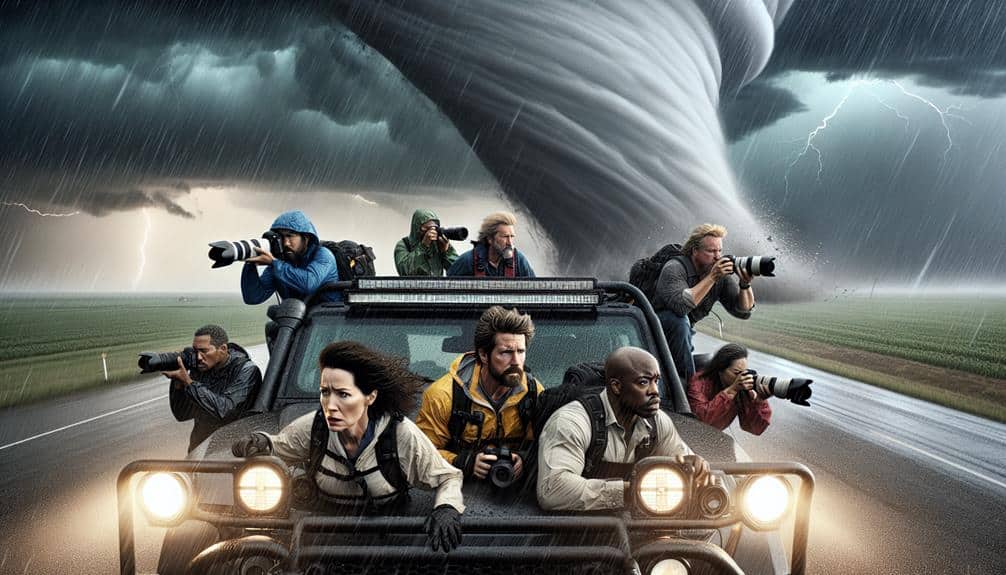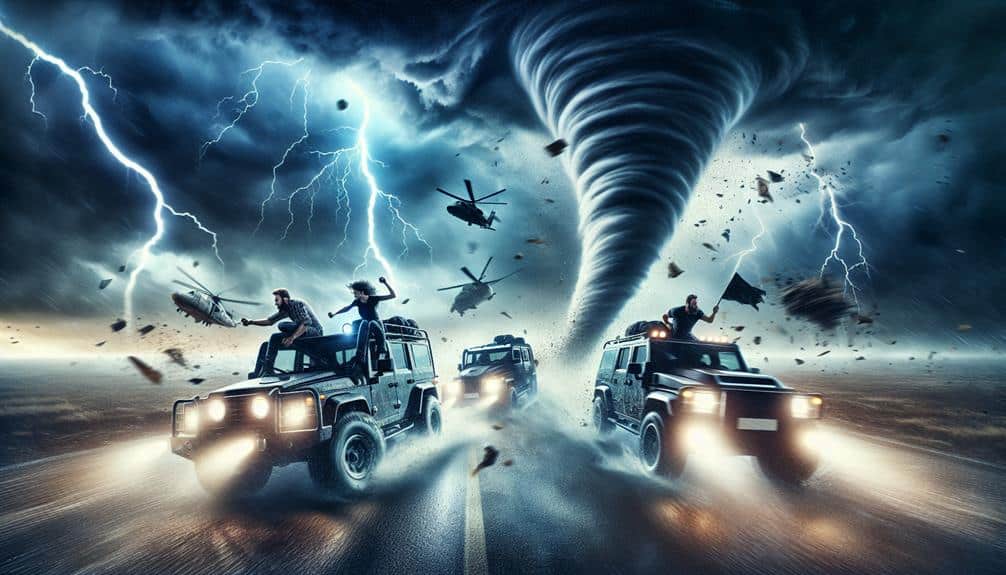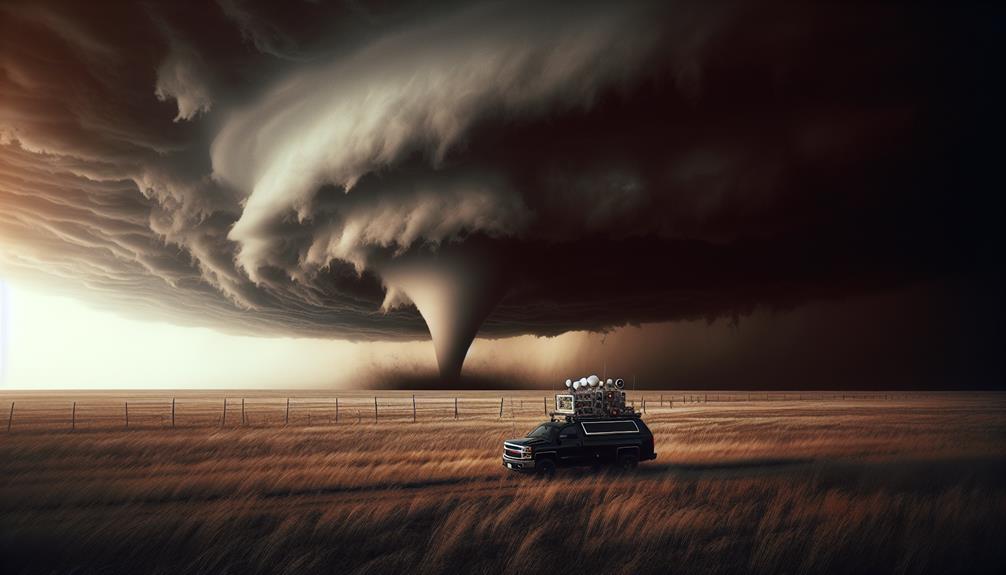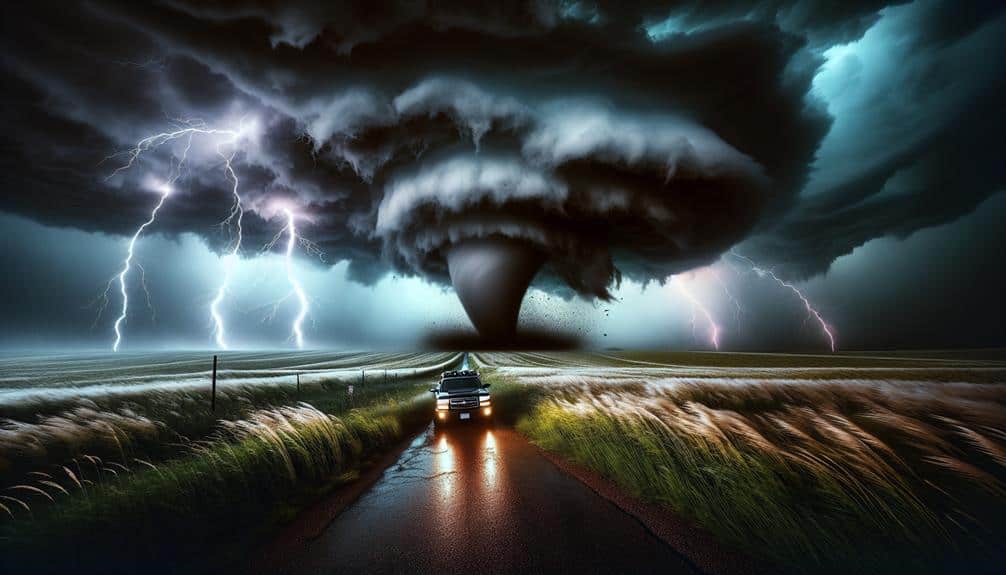We reveal the secrets of storm chasing documentaries by combining atmospheric dynamics with cutting-edge technology. We use high-definition cameras, portable weather stations, and GPS systems to capture the raw power of storms, ensuring each chase is a blend of science and adventure filmmaking. Safety protocols, including reinforced gear and real-time data analysis, are essential for minimizing risks. Advanced drones and editing techniques like time-lapse enhance the visual allure. Our crew communicates seamlessly, using predictive modeling and Doppler radar to track weather events accurately. If you want to discover more about our process, there’s an intricate journey ahead.
Key Points
- The blend of atmospheric dynamics and real-time data analysis drives the excitement in storm chasing documentaries.
- High-definition cameras, drones, and weather-tracking equipment are essential for capturing compelling storm footage.
- Safety protocols, including reinforced gear and emergency response plans, are crucial for minimizing risks during expeditions.
- Advanced editing techniques like time-lapse and slow-motion enhance the visual impact of storm footage.
The Thrill of the Chase
The thrill of the chase in storm chasing documentaries arises from a combination of atmospheric dynamics, real-time data analysis, and the sheer unpredictability of severe weather events. We’re driven by an adrenaline rush, fueled by the high stakes of capturing compelling storm footage. Each chase is an intersection of science and adventure filmmaking, demanding precision and flexibility.
We rely on atmospheric models and radar data to predict storm development and movement, but nothing can fully prepare us for the chaos on the ground. Tornadoes, supercells, and lightning storms each present unique challenges. The unpredictability of these phenomena keeps us on edge, intensifying the excitement.
Real-time data analysis is essential. We continuously monitor changes in wind shear, barometric pressure, and humidity levels to adjust our strategy. This not only guarantees our safety but also maximizes our chances of filming the most dramatic moments. The combination of high stakes and adventure filmmaking pushes us to our limits, both physically and mentally.
In those heart-pounding moments, the line between danger and discovery blurs. We’re not just chasing storms; we’re capturing the raw power of nature, sharing an experience that embodies freedom and awe.
Gear and Equipment
Essential tools like high-definition cameras, portable weather stations, and GPS systems form the backbone of our storm chasing arsenal. Our high-definition cameras capture the intricate details of storm formations, enabling us to analyze and document phenomena with unparalleled precision. Portable weather stations provide real-time data on temperature, humidity, and barometric pressure, vital for predicting storm behavior. GPS systems guarantee we can navigate treacherous conditions with pinpoint accuracy.
Gear maintenance is crucial; malfunctioning equipment can compromise both our safety and the integrity of our data. Regular checks and calibrations are non-negotiable. Storm protection for our gear, such as waterproof casings and shock-absorbing mounts, is indispensable to withstand harsh weather conditions.
Technology advancements have greatly lessened some filming challenges. Drones equipped with high-definition cameras allow us to capture aerial views of storms, providing perspectives previously unattainable. However, these advancements come with their own set of challenges, such as battery life limitations and susceptibility to high winds.
Despite the cutting-edge technology, filming challenges persist. Low light conditions, rapid weather changes, and the sheer unpredictability of storms demand that our equipment be both versatile and resilient. Our commitment to leveraging and maintaining advanced gear guarantees we capture the raw power of nature in its most unfiltered form.
Safety Protocols
When storm chasing, we must prioritize safety by using essential safety gear such as helmets and GPS devices.
We should also establish thorough emergency response plans to address potential hazards.
Additionally, conducting in-depth risk assessment strategies based on meteorological data can mitigate dangers and enhance our operational safety.
Essential Safety Gear
Proper safety gear, including helmets and reinforced vests, is essential for minimizing risks during storm chasing expeditions. We need these items to shield ourselves from flying debris and high-velocity winds.
Adhering to strict safety precautions and constantly monitoring weather alerts are non-negotiable practices. Advanced weather alert systems enable us to predict storm trajectories and respond swiftly to any changes, making sure we’re not caught off guard.
Equipping our vehicles with thorough emergency supplies is another critical measure. This includes first aid kits, fire extinguishers, and multi-tools. Communication devices, such as two-way radios and satellite phones, guarantee we maintain contact with our team and emergency services, even in areas where cellular networks are unreliable. These devices are lifelines, providing real-time updates and coordination.
Our gear isn’t just about what we wear; our vehicles also need to be storm-ready. Reinforced glass, durable tires, and strong suspension systems help us navigate treacherous terrains safely. We rely on data-driven choices to select and maintain our gear, always opting for proven reliability.
Embracing these measures, we maximize our safety while chasing the thrill of the storm, balancing the quest for freedom with scientific precision.
Emergency Response Plans
Our emergency response plans, meticulously crafted and rigorously tested, are the cornerstone of our safety protocols during storm chasing missions. These plans are designed to ensure that we can swiftly and efficiently respond to any hazardous situation that may arise.
Firstly, our evacuation procedures are thorough and well-defined. Each team member is extensively trained in these procedures, enabling us to leave a dangerous area swiftly. Key to this is our communication protocols, which utilize both radio frequencies and satellite phones to maintain constant contact with all team members and emergency contacts. This guarantees that everyone is aware of any changes in the storm’s behavior and can act accordingly.
Additionally, we’ve identified multiple shelter options along our planned routes. These shelters range from sturdy buildings to specially equipped storm chaser vehicles designed to withstand severe weather conditions. Knowing the exact locations and structural integrity of these shelters allows us to make informed decisions quickly.
Our emergency contacts include local authorities and meteorological experts who provide real-time updates, enhancing our situational awareness. By integrating these elements, we maintain a high level of preparedness, enabling us to navigate the inherent risks of storm chasing while safeguarding our freedom to explore extreme weather phenomena.
Risk Assessment Strategies
Effective risk assessment strategies are vital in our storm chasing endeavors, allowing us to systematically identify and mitigate potential hazards before they escalate. We leverage a combination of real-time data analysis and historical storm patterns to enhance our forecast accuracy. By understanding warning signs, such as rapid changes in barometric pressure and cloud formations, we can predict tornado genesis with increased precision.
Our risk mitigation protocol includes deploying advanced meteorological instruments like Doppler radar and LIDAR systems. These tools give us high-resolution data on storm dynamics, enabling us to make split-second decisions. For instance, Doppler radar helps us identify mesocyclones, which are precursors to tornadoes, providing essential lead time for evasive maneuvers.
Safety measures are integral to our operations. We use reinforced vehicles equipped with GPS and satellite communication systems to maintain constant connectivity. Our team members undergo rigorous training in emergency medical response and situational awareness to handle a variety of threats, from flying debris to flash floods.
Capturing the Storm
When capturing the storm, we rely on essential filming equipment like high-resolution cameras and stabilized mounts to guarantee clarity despite turbulent conditions.
Accurate weather tracking techniques, including Doppler radar and satellite imagery, enable us to predict storm paths and position ourselves effectively.
Combining these technologies maximizes our ability to document storm phenomena with scientific precision.
Essential Filming Equipment
To capture the raw power and intricate details of a storm, we need high-resolution cameras equipped with wide dynamic range sensors and sturdy tripods for stability amidst turbulent conditions. These cameras allow us to record the subtle gradations of light and shadow that define the storm’s structure, guaranteeing we don’t miss any essential details. Wide dynamic range sensors are particularly vital for balancing the stark contrasts between the storm clouds and lightning.
Our camera angles are meticulously planned to maximize the visual impact. Low angles can emphasize the towering nature of storm clouds, while high angles can provide a sweeping view of the storm’s path. Editing techniques like time-lapse and slow-motion are crucial for highlighting the storm’s progression and dramatic moments.
Lighting and sound design can’t be overlooked. Portable, weather-resistant LED lights help us capture clear footage even in low-light conditions. For sound, directional microphones and windshields are indispensable, as they filter out background noise and focus on the storm’s intense audio elements. The roar of thunder and the hiss of rain must be captured with precision to convey the storm’s full majesty.
Weather Tracking Techniques
While our advanced equipment guarantees high-quality footage, accurately capturing a storm’s evolution demands precise weather tracking techniques. We rely on predictive modeling to forecast storm behavior, allowing us to be in the right place at the right time. Predictive models utilize vast datasets, including historical weather patterns, real-time satellite imagery, and atmospheric pressure readings. By analyzing this data, we can anticipate the formation, trajectory, and intensity of storms.
In the field, data collection is essential. We employ Doppler radar, anemometers, and barometers to gather real-time meteorological data. The Doppler radar helps us track precipitation and wind speeds within the storm, while anemometers measure wind velocity, and barometers record atmospheric pressure changes. This information is crucial for understanding the storm’s dynamics and making informed decisions on positioning.
Storm photography also benefits from these techniques. Knowing the storm’s likely path lets us set up cameras in ideal locations to capture dramatic footage of lightning strikes, funnel clouds, and other phenomena. This precise tracking ensures we document the storm’s full lifecycle, from inception to dissipation, in stunning detail.
Combining predictive modeling with meticulous data collection enables us to present a compelling and scientifically accurate narrative of storm behavior.
Crew Dynamics

Understanding crew dynamics is essential in storm chasing as it directly influences operational efficiency and safety protocols. Our teamwork dynamics hinge on seamless communication strategies that guarantee everyone is on the same page. Real-time data sharing and constant updates about weather conditions are critical. We’ve adopted advanced communication tools, such as encrypted radio channels and satellite phones, to maintain connectivity even in remote areas.
Effective leadership roles are crucial in high-stress environments. Our team leaders possess extensive meteorological knowledge and crisis management skills, guiding us through unpredictable weather scenarios. They make key decisions swiftly, prioritizing safety without compromising our mission.
Conflict resolution is another important aspect of our crew dynamics. When tensions arise, whether due to differing opinions on storm paths or stress-induced fatigue, we rely on structured conflict resolution techniques. These include mediated discussions and predefined protocols for decision-making. This ensures that conflicts are resolved quickly, allowing us to refocus on our primary goal: capturing the raw power of nature.
Post-Production Process
In the post-production process, we meticulously analyze terabytes of raw footage and meteorological data to create a compelling and scientifically accurate narrative. Our team employs advanced editing techniques to sift through hours of storm footage, selecting the most visually and scientifically significant moments. We use non-linear editing software that allows us to handle large data files efficiently, ensuring that each cut enhances the narrative flow while retaining scientific integrity.
Sound design is another critical component. We isolate and amplify natural storm sounds, like thunder and wind, using high-fidelity audio tools. This enhances the immersive experience and underscores the raw power of nature. Additionally, we integrate layered soundscapes to simulate the auditory experience of storm chasing, making the audience feel as if they’re on the front lines with us.
To maintain scientific accuracy, we cross-reference meteorological data with the footage, ensuring that every visual element aligns with real-time weather phenomena. This data-driven approach allows us to craft a documentary that’s both educational and thrilling.
Through precise editing techniques and meticulous sound design, we deliver a final product that captivates audiences while honoring the complexities of storm chasing.
Frequently Asked Questions
How Do Storm Chasers Fund Their Expeditions?
We fund our storm-chasing expeditions through sponsorship opportunities and fundraising events. Additionally, we seek financial support via crowdfunding campaigns. These methods provide necessary funding, enabling us to continue our research and explore the science of severe weather.
What Qualifications Are Needed to Become a Storm Chaser?
How do we become storm chasers? It’s a blend of educational background, experience, necessary equipment, and rigorous training. With meteorology degrees and hands-on fieldwork, we gain the expertise and tools essential for safely and effectively chasing storms.
How Do Storm Chasers Decide Which Storms to Follow?
We analyze weather models, perform risk assessment, and use strategic planning to decide which storms to follow. By evaluating atmospheric data and potential hazards, we guarantee our pursuit balances scientific objectives with safety considerations, granting us freedom in exploration.
Are There Any Ethical Concerns in Storm Chasing?
We must consider ethical concerns in storm chasing, focusing on media representation and consequences. Ensuring public safety is paramount, and we have a responsibility to avoid endangering others while capturing data-driven, scientifically accurate content.
How Do Storm Chasers Handle Encounters With Local Authorities?
We coordinate with local authorities by sharing real-time data, ensuring public safety is prioritized. When handling media inquiries, we emphasize our scientific objectives and protocols to maintain transparency and gain cooperation. This approach fosters trust and facilitates smooth operations.


